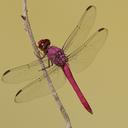United States and Canada
This species has a red face and orange labrum. Young individuals are brown with an unmarked thorax that is orange-yellow ventrally. The top of the head turns dark metallic violet in mature males and the thorax and abdomen become reddish with uniform purple pruinose overcast in both sexes. The wings are clear with dark wing veins. There is a wide, dark, lateral flange on segment 8 in females. The black vulvar lamina meet at slight angle, forming shallow V.
Size: Total length: 47-56 mm; abdomen: 33-39 mm; hindwing: 35-44 mm.
Similar Species (south-central US): The only species likely to be confused with it is the similar and more widespread Roseate Skimmer (O. ferruginea). That species is more magenta or purple. The ventral side of the thorax is grayish-yellow often has distinct dark markings on the ventrolateral portion of the metepisternum that are generally not present in the Orange-bellied Skimmer. The sides of the thorax in the Roseate Skimmer have a distinct pale yellow stripe along the ventral suture. The wing veins are more orange and the lateral flange of abdominal segment 8 in females is pale. The vulvar lamina in the Roseate Skimmer are parallel forming a short-armed U. Flame (Libellula saturata) and Neon (L. croceipennis) Skimmers each lack lateral thoracic markings and have much stockier bodies. Red-tailed Pennant (Brachymesia furcata) is smaller and has amber basally in the hindwing.
Habitat: Temporary and permanent ponds, lakes, ditches and slow streams.
Natural History: This species was considered a southern form and synonym of the similar Roseate Skimmer. Both tropical king skimmers in the region can occur together. It is unclear exactly what behavioral differences there may be, but early observations suggest Orange-bellied Skimmer may prefer shady areas. Where both occur together, Orange-bellied Skimmer seems to be more abundant. Novelo's (1981 ) behavioral study of Roseate Skimmer, may have included both species. The early and late dates listed above reflect relatively few observations in the region. It is found year round throughout most of its range. In the Texas, this species can be locally abundant at locations in the lower Rio Grande Valley and on the King Ranch in Klebburg County.
Distribution: Central and south Texas south through Central America
Source: Abbott, J.C. 2006-2010. OdonataCentral: An online resource for the distribution and identification of Odonata. Available at OdonataCentral.
Edited by Drew Weber (9/24/2015).
